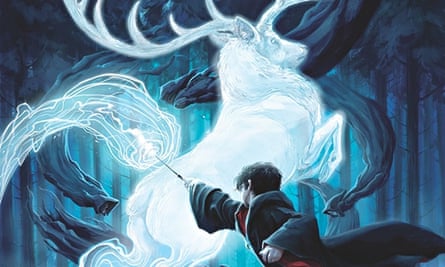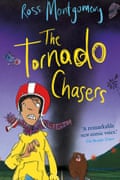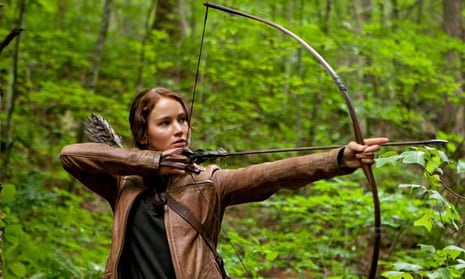Give a group of children the opportunity to hurt themselves and they’ll come up trumps every time. This means they spend most of their childhood being told to not do anything even remotely unsafe. While these instructions are usually reasonable, they make no sense to children because they’ve never had the opportunity to learn why they shouldn’t run downstairs in wet shoes with a tray full of scissors. Fiction is one of the few environments left in which they can explore and experience danger without being told off.
In my new book The Tornado Chasers, I imagined what it might be like to live in a town where safety is valued above all else – and what might happen when a group of children decide to break every rule in the book and run straight into the centre of a raging hurricane. In that tradition of irresponsibility and poor forward-planning, I look at some of the best children’s books with a lax approach to death, disaster and dismemberment.
1.Charlie and the Chocolate Factory by Roald Dahl
Roald Dahl is in a league of his own when it comes to brutally knocking off children, which is probably why they still adore him. You could choose any of his books, but this really is the zenith of health-and-safety fails: a factory tour where the visitors get made into nougat and the machines are run by workers who are paid in chocolate and come from a place no one’s ever heard of. The proposed sequel, Willy Wonka and the Human Rights Tribunal, never saw the light of day.
2. The Subtle Knife by Philip Pullman
In Pullman’s His Dark Materials trilogy, young Will Parry is given control of a knife that’s so sharp it can cut through the fabric of the universe. In less time than it takes for you to say: “Hang on Will, I’m not sure that’s a very good i…” he’s already sliced off his fingers. There’s nothing subtle about the amount of Savlon he’s going to go through sorting that out.
3. Holes by Louis Sachar
Young Stanley Yelnats is sent to Camp Green Lake for a crime he didn’t commit, where the inmates are forced to dig holes in the desert all day to “build character” and the wardens don’t care if you live or die. Just in case that was too much like fun, there are also yellow-spotted lizards in the ground whose bites kill instantly.
4. Half Bad by Sally Green
The witches in Green’s recent YA thriller are able to quickly heal themselves, which means our protagonist Nathan can withstand some truly eye-popping levels of sadistic violence. Top of these is a bracelet he’s forced to wear which, when he tries to escape from prison, covers his hand in acid. He spends the rest of the book with melted fingers, which thankfully doesn’t stop him from pummeling everyone in sight into a bloody paste.
5. A Series of Unfortunate Events: The Erszatz Elevator by Lemony Snickett
Of the three Baudelaire children, it’s infant Sunny who is blessed with the most impressive talent: having really, really sharp teeth. Unfortunately the three orphans are too busy trying not to get murdered to book her in for a scheme of corrective orthognathic surgery, so she’s free to use them for teeth-sword fights and to chew her way up an elevator shaft.
6. Rooftopppers by Katherine Rundell
This recent award-sweeper follows Sophie, an orphan on the search for her mother, as she sneaks and scales across the rooftops of Paris. A bit dangerous, surely? What does foster father Charles have to say about her tightrope-walking between buildings? “As long as you aren’t doing anything too extravagantly illegal, I am happy for you to have secrets”. That’s it?! Blimey. So much for just letting her go headfirst down the slide.
7. The Grimm’s Fairytales by The Brothers Grimm
While we’re at it, let’s not forget old fairytales happily presented children with fantasy worlds more akin to Game of Thrones than Frozen. In the original Cinderella, to pick one horrific example, the Ugly Sisters try to fool the Prince by cutting off their toes so they can fit their feet into the glass slipper. And then they get their eyes pecked out by pigeons. It’s hard to imagine one of them breaking out into “Let It Go” after that.

8. Harry Potter and The Prisoner of Azkaban by JK Rowling
So: I’m not a headmaster, and I haven’t been forced to make life-or-death decisions in the face of evil. Nevertheless I think we’re all agreed that giving three 13-year-olds the power to turn back time and alter the course of history is, at best, a fairly irresponsible decision. Even if it does mean Gryffindor can win the House Cup (FINALLY).
9. The Tiger Who Came to Tea by Judith Kerr
Look, if you open the front door and there’s a tiger outside, the first rule is that you don’t invite them in. Don’t come to me acting all surprised when he’s eaten all the sandwiches and drunk all the tea in the teapot.
10. The Hunger Games trilogy by Suzanne Collins
Let’s not even get started.

